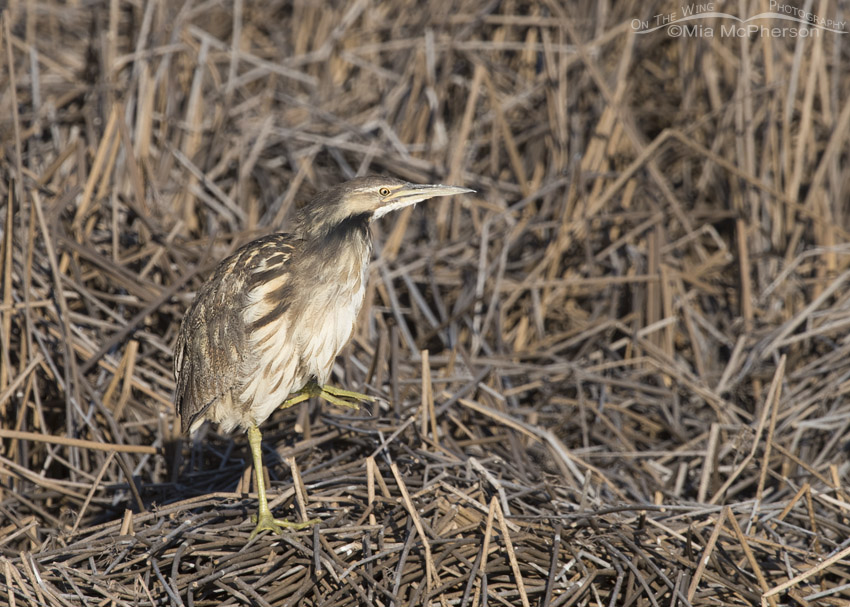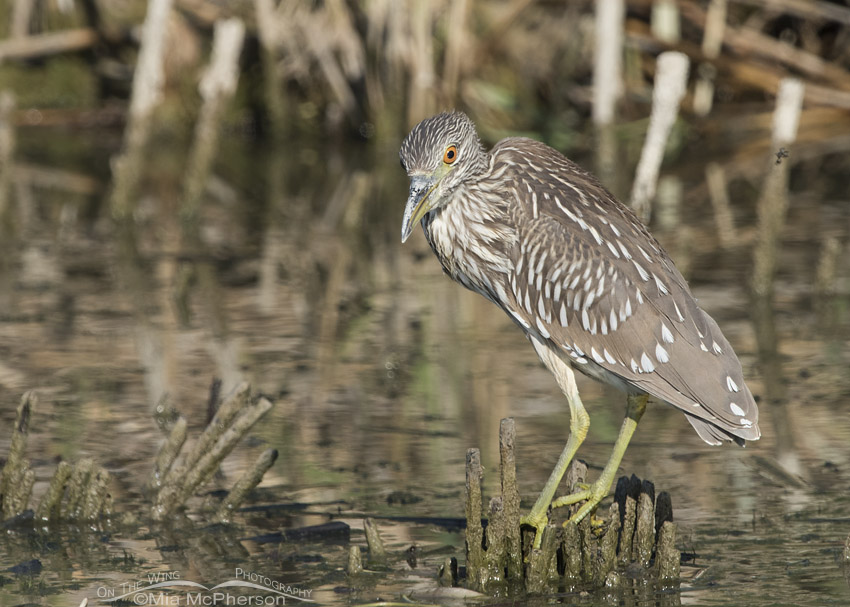 American Bittern standing on one leg – Nikon D810, f7.1, 1/1600, ISO 400, -0.3 EV, Nikkor 500mm VR with 1.4x TC, natural light
American Bittern standing on one leg – Nikon D810, f7.1, 1/1600, ISO 400, -0.3 EV, Nikkor 500mm VR with 1.4x TC, natural light
A couple of times over the past few months I have come across photos that were taken locally in northern Utah on image searches via Google that claim to be American Bitterns but they are actually photos of juvenile Black-crowned Night Herons.
My problem with those mistaken ID’s are that the photographers claim to be professionals and some of the images are being sold as American Bitterns. As a professional bird photographer and birder it bothers me to see obvious mistaken identifications happen on stock image sites because the unsuspecting buyer of the image could wind up with egg on their face by using a juvenile Black-crowned Heron on a web site or book where they wanted an American Bittern.
To the untrained eye American Bitterns and Black-crowned Night Herons can be confused so I thought I’d visually compare the two species with other keys to aid in their identification.
American Bitterns have small heads, long necks and bulky bodies, their plumage contains warm brown and buff colors and their yellow to light orange eyes are small. American Bitterns have sharp, straight dagger-like bills plus they have pronounced streaky plumage, especially on their necks. They are also more often heard than they are seen.
 Juvenile Black-crowned Night Heron looking right at me – Nikon D810, f8, 1/1250, ISO 400, -0.3 EV, Nikkor 500mm VR with 1.4x TC, natural light
Juvenile Black-crowned Night Heron looking right at me – Nikon D810, f8, 1/1250, ISO 400, -0.3 EV, Nikkor 500mm VR with 1.4x TC, natural light
Juvenile Black-crowned Night Herons may look similar to American Bittern in the photo above but by looking carefully at the two images they can be seen as two different species.
Juvenile Black-crowned Night Herons do have brownish plumage but the tone is cooler that the warmer browns of the American Bitterns. Although the juvenile Black-Crowned Night Herons do have streaky necks and chests the streaks on their necks are not as sharply defined or pronounced and their bodies are not streaked but instead show spots on their backs and sides. Black-crowned Night Heron juveniles have much larger eyes (for hunting at night) than American Bitterns do and their orange color is more vibrant. Also the juvenile Black-crowned Night Herons have thicker necks and bills than the American Bitterns do.
The chances of finding an American Bittern out in the open are very much lower than finding juvenile Black-crowned Night Herons, who are far more common, out in the open at Farmington Bay WMA or Bear River Migratory Bird Refuge.
Life is good.
Mia
Click here to see more of my American Bittern photos plus facts and information about this species. Click here to see more of my Black-crowned Night Heron photos plus facts and information about this species.


Nice images and a helpful post. Hard to believe professionals would make this error.
Life is definitely good when your local birding spots allow you to get such nice images of these species.
I can see how most people could confuse the two, but “professionals” should certainly learn the difference, especially when they attempt to pass on or profit from their “knowledge”….we have a couple of self-proclaimed bird “experts” around here who freely (and arrogantly!) spout BS, esp. at places like our annual Eaglefest….people who don’t know better eat it up….
Beautiful images, Mia.
Great post. We see Black-crowned Night Herons often down here in Arizona and very rarely see American Bitterns. On several occasions I’ve had individuals report to me that they’d seen a bittern when, in fact, the bird was a juvenile Black-crowned Night Heron. When I’m out photographing, the first thing I look at is the bird’s eye. At a distance one species can easily be confused with the other but the juvenile Black Crown Night Heron’s eyes are unmistakable.